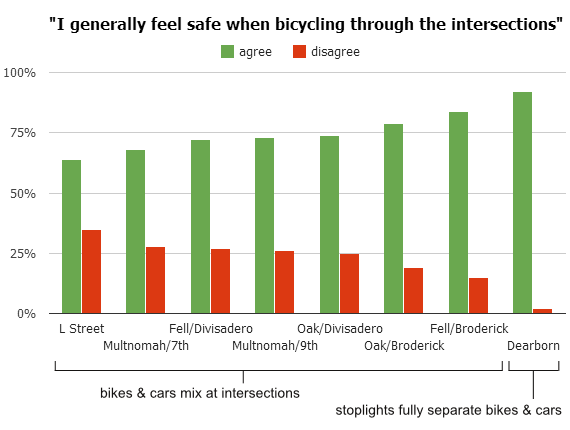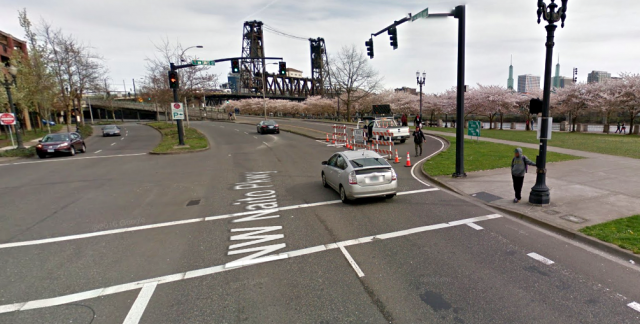
(Image: Portland Bureau of Transportation)
Safety advocates are trying to balance enthusiasm for the city’s newly announced Naito bike lanes with concern over one key detail.
After nine years of delay, the plan to close the “Naito Gap” in the next few days drew joy from people like Reza Farhoodi, planning and transportation committee co-chair at the Pearl District Neighborhood Association and a member of the city’s Bicycle Advisory Committee. But Farhoodi said it would be a “terrible mistake” for the city not to use a right-turn arrow signal to protect bikes from right-turning autos as the bikes head north across the Steel Bridge onramp.
Today, Naito’s northbound bike lane ends immediately south of the onramp. It starts up again 1,500 feet to the northwest. As we reported yesterday, converting a passing lane to a wide buffered bike lane in each direction will create a major new bike route between northwest Portland, the Willamette River and downtown. It could easily carry 1,000 bikes a day within a few years.
But Naito’s onramp to the Steel Bridge at Davis carries 450 to 500 cars during the peak hour alone, all of them making a shallow-angle turn across a bike lane in which people will mostly be heading straight.
“Putting an unprotected right turn lane to the left of a bicycle lane is substandard practice and just puts cyclists at risk of right hook collisions,” Farhoodi said in an email Thursday morning. “There is a reason why practitioners almost never use this design.”
(Farhoodi, whose day job is with an active transportation planning firm that often competes for city contracts, softened his judgment somewhat in later emails, after continuing to learn about the situation — see below.)
A signal would at least triple project cost, city says

(Photo: J.Maus/BikePortland)
Each of the two northbound lanes on Naito already has its own hanging signal here, and the city’s plan would convert the rightmost lane to a right-turn-only lane. So why not create a bike-specific signal phase, like the one that prevents right hooks across the river at NE Williams and Broadway?
Portland Bureau of Transportation staff said Thursday that though delay from a new signal phase might risk causing southbound traffic to back up across the railroad tracks, the “major” obstacle to a protected signal phase here is money.
The Naito project, PBOT spokeswoman Hannah Schafer said, is funded through the bureau’s “Missing Links” program, which has an annual budget of $75,000. Most “Missing Links” projects cost $5,000 to $10,000; Shafer said restriping the newly repaved roadway will cost $15,000 (with Missing Links covering the full expense). A signal would bring the total cost to $45,000 or so in a “best case” scenario, she said.
The additional $30,000 would include “a bike signal and right turn only signal including all labor, materials, engineering, traffic control, and a structural analysis of the existing mast arm pole on the north side of the intersection,” she said.
“Missing Links never pays for signals,” PBOT project manager Scott Cohen said. “It just doesn’t happen.”
A mixing zone is possible but would have problems too

(Image: PeopleForBikes)
Portland Bureau of Transportation engineer Mark Haines argued that the striping proposed for Naito wouldn’t make the situation worse. He noted that there is an uphill grade to Naito at this point, making it less likely that people biking will overtake people in turning cars.
“I this case I think cyclists and drivers can work together at lower speeds,” he said. “And ultimately I think it’s the driver’s responsibility to yield.”
Though turning vehicles must always yield to vehicles that are moving straight, many Oregon drivers don’t realize that this applies to bike lanes, too. The city’s Naito plan calls for a zebra-striped green crossbike across the intersection, plus a new sign reminding people to yield to bikes before turning.
Another complication: this project is only happening at all because Naito has just been repaved north of Davis.
“We saw the fresh pavement, decided this was the moment,” Schafer said.
Advertisement
The new asphalt starts immediately north of the onramp — meaning that any striping changes next to or south of the onramp would require costly stripe removal work.
Despite that, Haines said the city considered a green bike box, a mixing zone that would prompt bikes and turning cars to negotiate their way into the same lane, or markings to move the bike lane to the left of the right-turn lane, like the one at Naito and Morrison.
But because any variety of mixing zone would be so busy with right-turning cars, Haines said, “that would be very unhelpful for some people too.”
If people feel the new bike crossing is unsafe, Haines said, they can choose to move into the center of a general travel lane with their bike and go straight across the intersection. (There’s an exemption for this situation in the Oregon law that requires people biking to use a bike lane if present.)
Haines also noted that thanks to the new right-turn lane, people biking will at least have more certainty that any car in the right lane is going to turn.
City and advocates hope for more funding soon
Biking advocates said Thursday that though they understand the city’s position, they would like to see more changes as soon as possible. Here’s how Farhoodi put it later Thursday, after learning more about the city’s reasoning:
I trust the professional judgment of PBOT staff, but think that they will receive a lot of negative feedback about a design that many people perceive to be unsafe because it manufactures conflict. For me, my major concern is that this could give cyclists a false sense of security compared to a design that drops the bicycle lane in favor of a shared turning/bike lane for a short stretch. Neither of these are preferable to a protected turn signal, but that’s the reality of the funding situation right now.
But we’ve waited too long to close the Naito Gap to rethink it now, and there is also the “safety in numbers” argument that closing the gap will increase bicycle volumes on Naito as a result of improved connectivity. In any case, I sincerely hope that PBOT’s proposed design will be safe for all users, and that they will revisit this location soon when more funding is available, perhaps with the upcoming Central City Multimodal Safety Project.
Here’s Sarah Newsum, a spokeswoman for the Bicycle Transportation Alliance:
In a confusing intersection, such as the one at NW Davis and Naito, we will always advocate for physical separation and signal differentiation. Ideally coupled with a bike box and “No right turn on red” signs. We’d like to see this intersection mirror that of NE Broadway and N Williams, with a separate advanced signal for people riding bikes. Signs telling people driving to watch out for bikes do not provide the necessary clarity or safety for any road user. …
The striping plan isn’t necessarily making that intersection less safe than its current design, however, additional traffic on the street will bring a potential increase in conflicts.
And Ian Stude, chair of the city’s Bicycle Advisory Committee, in response to a question about a red-turn arrow:
• Very excited to see this gap completed!
• Red turn arrow you suggest would provide some added protection for riders, but a red turn arrow does not prohibit a turn on red, so it would need to accompanied by a “no turn on red” designation as well.
• My suggestion for reducing potential right hook conflicts would be to use the space between Couch and Davis to create a merge point, moving the bike lane to the left of the turn lane prior to the intersection at Davis.
Schafer, Cohen and Haines said they expect the work to go ahead as planned in the next few days. They hope the street can be further improved in the future.
“We’ve actually been able to make some pretty big impacts for people,” Schafer said. “I think this is the first phase of what we hope to be additional improvements to come. … As always, we will be monitoring this area closely after the striping is complete. The safety of Portland’s road users is the bureau’s highest priority.”
“Maybe with the permanent Better Naito, if that ever gets budgeted again,” Haines added. “We’re hopeful that it will.”
Correction 12:35 pm: An earlier version of this post gave the wrong estimated cost for a combined restriping/signalization project.
— Michael Andersen, (503) 333-7824 – michael@bikeportland.org
Our work is supported by subscribers. Please become one today.


